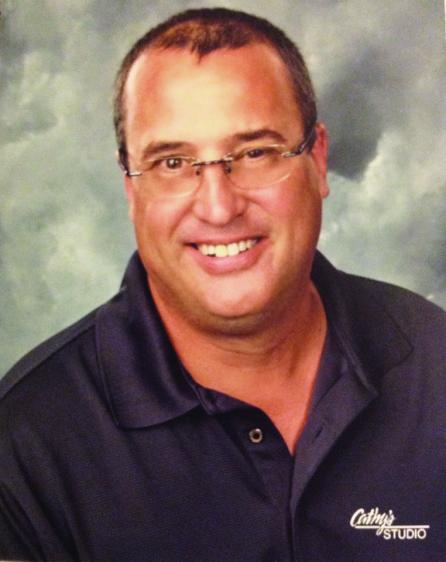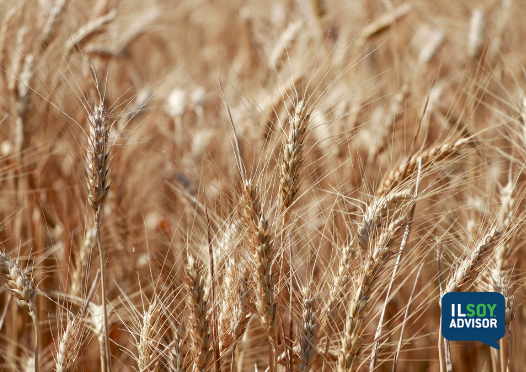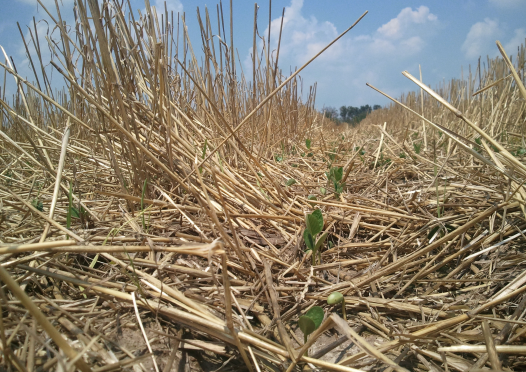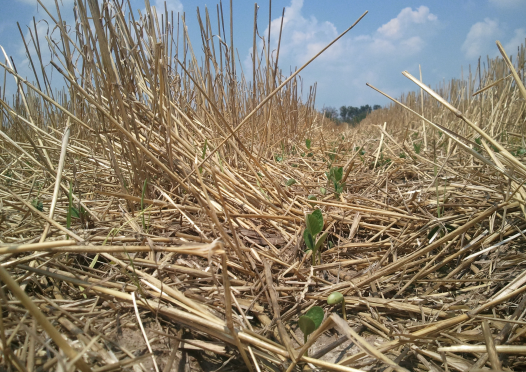ILSOYADVISOR POST
Agronomy: Considerations for Double Cropping
I was reminded today that wheat harvest is not far away. No, it wasn’t seeing a combine sitting out by a shed. It wasn’t even headed or flowering wheat. The sound of a helicopter flying on soybean seed was a reminder that wheat harvest is a little more than a month away and double-crop soybean planting is underway. How can that be? It’s still early May and many down here in Southern Illinois have yet to finish corn planting, let alone start much bean planting. There are two ways to get your double-crop beans planted early. One way is to harvest your wheat early at higher moisture. The other is to interseed your beans into standing wheat.
Flying on soybeans into standing wheat is nothing new. It has been done for many years in an attempt to get the soybeans “planted” earlier. This practice involves dropping soybean seeds from the air from a helicopter or airplane and having them fall through the standing crop, impacting into the soil.
Many things have to work out just right for this to be successful. First, the soil needs to be wet, ideally saturated. With the recent rains and saturated soil conditions, bean seeds will impact and “sink” or “settle” into the soil somewhat. This will allow the bean to absorb moisture and begin to swell and germinate. However, the field needs to remain wet once germination begins to allow the radical to find a place to penetrate the soil and attach to it so it can support the hypocotyl as it pushes the cotyledon towards sunlight. If the soil dries out before the radical can establish in the soil, the plant will die. I am told from those that routinely use this practice that you need two weeks of moisture once the seeds are dropped for good stand establishment.
There are other issues with flying on soybeans into standing wheat. First is seed placement. It is not uncommon to have seeding take place outside the target area when using an airplane. Your neighbors may not be happy with your “overplanting.” Also, aerial seeding doesn’t give you good and even distribution like a drill or planter. Second, using treated seed is costly and when treated seed lands in someone’s pool, garden or other non-target area cleanup can be an issue. Third is ensuring enough moisture is present and for long enough to get a seedling established. And last, the amount of residue on the soil surface can effect germination as well, because seed laying on top of residue isn’t in contact with the soil and its supply of moisture.
The biggest issue, however, is crop insurance. Before considering aerial seeding of double-crop soybeans into an unharvested wheat crop, check with your crop insurance to see if it is an approved practice.
I do not recommend aerial seeding soybeans because there are way more things to go wrong than go right. It’s not good risk management.
However, early harvest of the wheat is an option that I favor to help get double-crops planted earlier. Many farmers harvest wheat near 20% and dry on the farm, similar to how they dry corn. Early harvest not only helps open the fields up for earlier double-cropping, but also helps to maintain and preserve the quality of the wheat. Even if you don’t have the capability to dry wheat on the farm, some millers will take wheat at 18% moisture and dry it in their facilities to help ensure quality. From a double-crop perspective, the major concern with early wheat harvest is that you will be planting into green or wheat straw. Planter adjustments will be needed to ensure good depth control and seed-to-soil contact.
So, as the airplanes and helicopters begin to fly and seed soybeans, look instead to consider early harvest as an option to get the jump on double-crop soybean planting and ensure a quality wheat harvest. Talk to millers and grain elevators in your area to see what programs they offer you could take advantage of to benefit both your wheat and soybean bottom line.
Kelly is serving as the Illinois Soybean Association Double-Crop Specialist. He was raised on the family farm in Benton, Illinois and graduated from Southern Illinois University (SIU)-Carbondale with a BS in Agriculture Education and Mechanization, and a Master’s of Science (MS) in Plant and Soil Science. Kelly has spent 25 years as a soil fertility agronomist and precision agriculture consultant in southern Illinois while also spending 4 years as a Farm/Agronomy Manager and GIS Coordinator for a large farm in southeastern Illinois. He is a Certified Professional Agronomist and a Certified Crop Advisor.





Comments
Add new comment